One of our most useful Australian rainforest trees for landscaping has to be the native frangipani tree. It produces clusters of fragrant creamy-white, frangipani-like flowers in spring that mature into buttery-yellow to orange in summer.
Aside from the striking flowers, the small evergreen tree features dark-green glossy leaves, a distinctive upright tapered form and low-maintenance requirements when cultivated.
It’s an easy choice for any gardener looking to establish a small ornamental tree in their landscapes. Here is everything you need to know to grow and care for native frangipani.
More...
Family: | Pittosporaceae |
|---|---|
Genus: | Hymenosporum |
Species: | H. flavum |
Common Names: | Native frangipani |
Location: | Outdoor |
Type: | Small tree |
Growth: | 4 to 15 metres tall, 3 to 8 metres wide |
Sun requirements: | Full sun to light shade |
Foliage Colour: | Green |
Flower Colour: | White, yellow |
Flowering: | Spring to summer |
Maintenance level: | Low |
Poisonous for pets: | Sap is mildly toxic to cats and dogs if ingested |
Introducing Native Frangipani
Many choose to establish this tree near entrances to their homes as the flowers have a sweetly tropical scent which can be very welcoming when guests visit.
These flowers will therefore naturally attract bees, butterflies and honey-eating birds, making this tree great for fauna-friendly gardens as well.
Once mature, the branches will become heavily foliaged and form in widely spread tiers, creating gorgeous silhouettes with an extremely attractive form within landscapes.
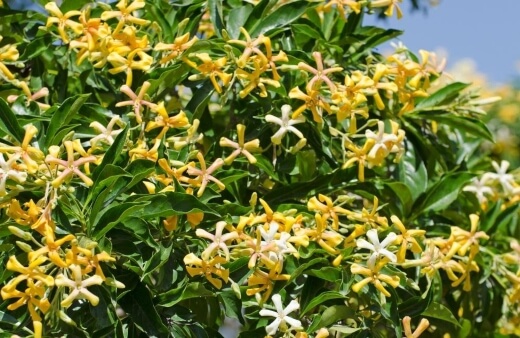
Native to Queensland, New South Wales and New Guinea, native frangipani forms a part of the Pittosporaceae family and is the sole species in its genus.
Botanically labelled as Hymenosporum flavum, the tree is closely related to the widespread genus Pittosporum but, despite its name, it is not closely related to frangipani or Plumeria at all. “Flavum” is Latin for yellow, referring to the tree's flower colour.
Native Frangipani Tree Growing Habits
In cultivation, it usually grows between 4 to 15 metres tall and 3 to 8 metres wide but, in its natural habitat, it can reach over 20 metres in height.
It is considered a fast-growing, low-flammable tree that, being a rainforest tree, does grow best in warm and humid environments. However, it is extremely adaptable and can grow in most areas in Australia.
It is most commonly planted as a feature specimen in landscapes but it can also be used for informal hedging, border screening and as a canopy for relaxed or formal garden settings.
Growing Native Frangipani in Australia
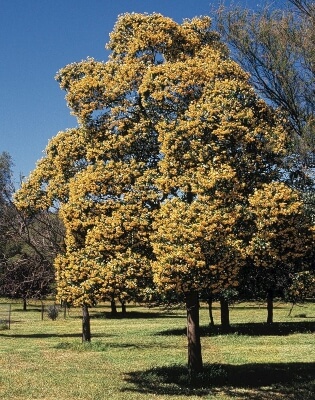
Source: treesandshrubsonline.org
After flowering, mature specimens will produce pear-shaped seed capsules that can be opened to collect the fertile winged seeds inside. You can use these seeds to grow your tree as seeds germinate readily within only about 8 weeks.
You can also propagate a healthy tree by using softwood or semi-hardwood cuttings. Another great option is to purchase a young and healthy nursery plant as these young specimens take far quicker to establish and don’t require as much effort on your part.


Get Your Free Guide:
Master Growing Australian Natives eBook
A Must Have Complete Guide for Every Australian Garden
Get Your Free Guide:
Master Growing Australian Natives eBook
A Must Have Complete Guide for Every Australian Garden
It is important to note that young seedlings can be sensitive to frost so some extra care will need to be taken in cooler climates if establishing seedlings.
Native Frangipani Propagation
Growing Hymenosporum flavum from Seed
- Collect your seeds from the seed capsules once they have dried in late summer.
- It is generally recommended to sow seeds in spring or autumn to avoid the hottest and coldest periods of the year.
- Ideal temperatures for germination are between 18 to 22°C.
- Soak your seeds in lukewarm water overnight.
- Prepare your well-draining growing containers filled with a porous seed-raising mix.
- Sow your seeds into the mix to a depth of about 1 to 2 mm.
- Water lightly after sowing.
- Place your containers in a warm shaded to a semi-shaded location away from harsh, direct light.
- Keep your soil medium continuously damp but never wet as the seeds can rot if overwatered.
- Germination should occur within 14 to 30 days depending on the conditions.
- Once your seeds have sprouted, allow them to develop further for at least another 4 to 6 weeks before transplanting them into larger containers.
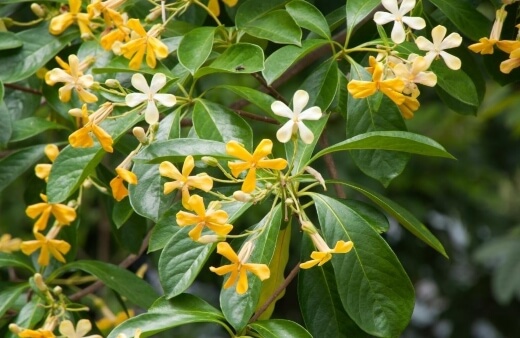
Propagating Native Frangipani Tree Using Cuttings
- The parent plant must be matured and disease-free.
- You can choose either a softwood cutting with mature wood at the base or you can use a semi-hardwood cutting. Just be sure not to use young stems.
- Using a clean and sharp pair of secateurs or gardening saw, take a cutting of between 15 to 50 centimetres in length. (Check out these affordable and durable pruning saws for reference).
- Remove the flowers and most of the leaves from the stem.
- Leave the cutting in a dry, well-ventilated area so that the base of the stem can become callous.
- Once the stem has dried out after about 4 weeks, you can prepare a container filled with coarse sand.
- Plant your cutting into the container, submerging the cut end into the growing medium.
- Water after planting then once every week or so until it takes root. New leaves are an excellent indicator that the cutting has rooted and healthy roots are developing.
- Allow your cutting to establish itself for a few more weeks once you see new growth.
Thereafter, you can transplant it into your desired growing position. For longer cuttings, a support stake may be needed while the tree develops in its forever home.
Native Frangipani Care Tips
Once established, this tree is easy to care for and it will tolerate light frost. The spreading branches may be weak to strong winds so be sure to consider its position in your landscape if you experience frequent strong winds.
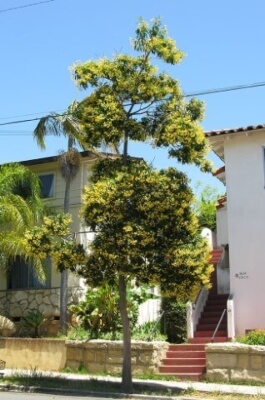
Source: futuretreehealth.com.au
Here are some of the basic care tips when growing your tree.
Watering Schedule
Water as needed to keep the soil lightly moist but never wet. Water moderately in spring to summer during the active growing season and water well in hot and dry spells.
Pruning Native Frangipani
Generally, pruning may not be needed as it can damage the shape of your tree as it grows. However, these trees can be pruned to your desired shape and size if you’re not interested in establishing a larger specimen in your garden.
Refer to our guide on pruning Australian native plants for more helpful tips.
Fertilising Needs
Feed your tree in spring with a dressing of bone-meal or a balanced organic fertiliser for the best results and bountiful flowering. A 2-3-2 or 3-1-5 garden fertiliser can work great. Alternatively, you can use an organic native fertiliser as well.
Clean-Up
After flowering towards late summer to early autumn, spent flowers will drop off your tree that will need to be cleared and removed from around the base.
Native Frangipani Tree Possible Pests & Diseases
Overall, very few pests and diseases plague this hardy native. However, in certain conditions, they can be prone to attack from scale insects.
Scale Insects
These insects usually appear as small, circular bumps on plants. They infest the stems and the foliage. They can be brown to cottony-white and measure 6 to 7 millimetres in length.
Infestation can lead to yellowing leaves and the growth of sooty mould which appears as a black, ask-like fungus that the insects excrete. Severe infestations can make your tree look miserable so treating them as soon as possible is very important.
You can apply some neem oil every couple of weeks or so to get rid of them. You can also use a similar horticultural spray. Keep treatment up until you see the sooty mold starting to disappear.
Native Frangipani FAQs

Are native frangipani roots invasive?
The root system is considered non-invasive when cultivated. However, be sure to account for its spreading branches as it grows.
Is native frangipani toxic?
It is far less toxic than true frangipanis but it does have a milky sap that can cause skin irritation and other digestive issues if ingested by kids, dogs or cats.
Why is my native frangipani turning yellow?
If it's not due to scale insects, there could be two possible reasons for this. You’ve either added un-composted organic matter into your soil or your soil has some sort of problem.
This could either be an iron deficiency, too much phosphorus or the soil pH is not right. Be sure to test your soil with a testing kit to see where you can improve it moving forward.
If you’re interested in also establishing a true frangipani in your landscape, be sure to check out our in-depth guide for more information and tips:
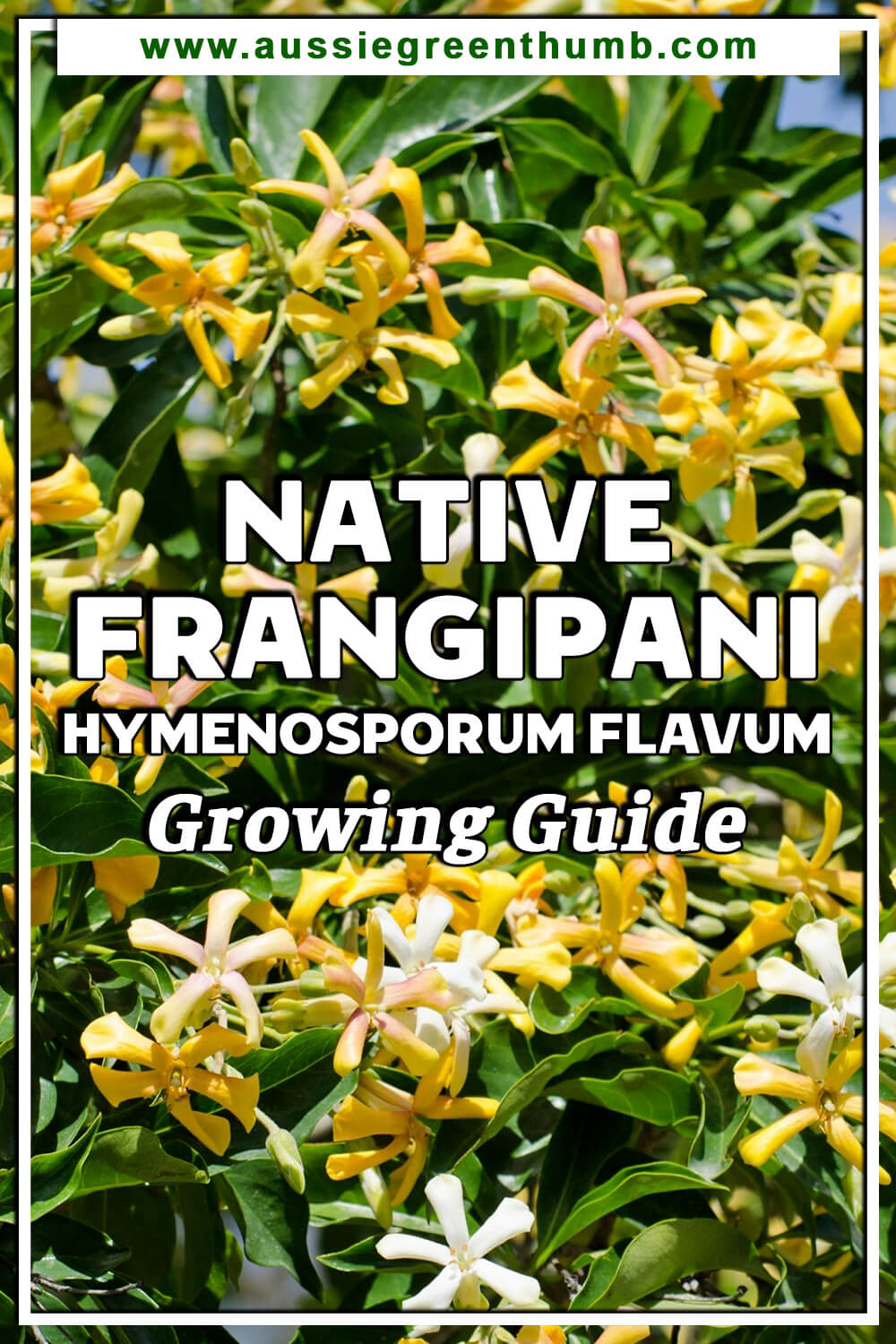
Add Some Indigenous Spectacle to Your Garden with the Native Frangipani Tree
This special rainforest tree is becoming highly sought-after in gardens for its spectacular flowering, very attractive form once established and its glossy green foliage.
It is an excellent option for any garden setting, particularly for native gardens that aim to attract local wildlife. The buttery-yellow flowers will add pleasant scents throughout your landscape and its pyramidal form will create relaxing silhouettes across your lawn.
Native frangipani truly is a one-of-a-kind addition to your small tree collection.
Published on July 23, 2022 by Nathan Schwartz
Last Updated on January 27, 2025





I live in a frost-free part east of Lake Macquarie.
Is the reason why my Native Frangipani because I have this 4 m high tree planted on the south side of a colourbond fence thus not getting much direct sunshine onto the lower trunk although the top 2 metres gets direct sun all yera round for 8-10 hours a day?
Hi Kevin,
If the lower part of the tree is suffering or has any sort of fungal problem showing (browning, of the stem, or orange coatings) it’s really important to add a gentle copper fungicide to the soil, and ideal some calcium or magnesium to support recovery (a basic tomato feed should do the trick).
In general though, an established frangipani should be happy in those conditions with a well-lit canopy and a shaded root system. The shade will help to support the root system, and take away any danger from extreme seasonal changes, while the sun will give something a little closer to its native environment and help to reduce and bud drop and the other common problems these gorgeous trees get in damp spaces.
In any case, the key to improving its health will be to make sure those roots stay well drained in winter, especially if there’s no sun to dry them out.
Best regards,
Gary Clarke